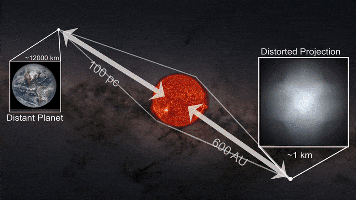May 03 2022
Using the Sun as a Lens
 Is it even theoretically possible to image in any detail the surface of an exoplanet light years away? An optical telescope would need to be many times the diameter of the Earth to produce such images. This “brute force” method of just building a giant telescope is probably never going to happen. Instead we need to find a more clever way, a method of exploiting the laws of physics to magnify distant images orders of magnitude beyond current technology. One idea gaining attention is using the sun as a giant gravitational lens.
Is it even theoretically possible to image in any detail the surface of an exoplanet light years away? An optical telescope would need to be many times the diameter of the Earth to produce such images. This “brute force” method of just building a giant telescope is probably never going to happen. Instead we need to find a more clever way, a method of exploiting the laws of physics to magnify distant images orders of magnitude beyond current technology. One idea gaining attention is using the sun as a giant gravitational lens.
In 1916 Einstein published his theory of General Relativity, which conceptualized gravity as a distortion of spacetime. He predicted that an object with a large gravitational field would even bend light. His predictions were validated with the 1919 total solar eclipse. During totality stars could be seen around the edge of the sun, and their apparent positions indicated that light from those stars had been bent as they passed near the sun. That validation gave a huge boost to acceptance of Einstein’s theory and made him a scientific superstar. Building on this idea he later predicted that a distant massive object with a light source directly behind it from the perspective of Earth would be surrounded by a ring of light from that more distant object – called an Einstein ring. Although relatively rare because they require a precise alignment, Hubble has found many examples.
In 1979 Von R. Eshleman wrote a paper in which he proposed that Einstein’s gravitational lens effect could be leveraged to image objects at interstellar distances. He wrote:
“The gravitational field of the sun acts as a spherical lens to magnify the intensity of radiation from a distant source along a semi-infinite focal line. A spacecraft anywhere on that line in principle could observe, eavesdrop, and communicate over interstellar distances, using equipment comparable in size and power with what is now used for interplanetary distances.”
He also anticipated the primary limiting factor of using this technique, “…the nearest point on the focal half-line is about 550 times the sun-earth distance.” (The average sun-earth distance is an astronomical unit, or AU.) It is common that ideas in science and technology have far deeper roots than we imagine. Ideas which seem cutting edge have often been anticipated by decades, and this is no exception. Fourteen years after Eshleman’s paper the ESA was presented with a proposed mission, FOCAL, which would use light sails to send a probe beyond the 550 AU distance necessary to use the sun as a lens. Keep in mind that 550 AU is the minimum distance, and the further you go the more distant objects you can image with a solar lens.
The idea was further explored in a book in 2009 by Claudio Maccone. The idea was resurrected again in 2020 when NASA physicist Slava Turyshev proposed a Direct Multi-pixel Imaging and Spectroscopy of an Exoplanet with a Solar Gravitational Lens Mission. This was when I first heard about the idea, 41 years after it was first proposed. The idea still exists as a curiosity among space enthusiasts, because there is no plausible way to get a mission out to 550 AU anytime soon. Current technology would take about a century to get there. Advanced craft, using light sails or nuclear engines, and making good use of gravity assists, would be necessary to get this flight time down to 20-40 years. Of course, we won’t have those technologies for 20-40 years or more, so no matter how you look at it, this is a project for the next century.
We can use that time to refine the idea and explore the relevant physics and underlying technology that would be necessary. A recent paper does just that – Integral Field Spectroscopy with the Solar Gravitational Lens, by Alexander Madurowicz and Bruce Macintosh. This is a proof of concept study, building on the earlier ideas put forward by Slava Turyshev in 2020. Turyshev proposed using a scope on a rocket that would take multiple images from different angles of an Einstein ring formed from the image of a distant exoplanet. The technique would require a powerful rocket and lots of fuel, so was not very practical. Madurowicz, however, built on Turyshev’s idea, developing an algorithm that can reconstruct an undistorted image of an exoplanet from a single source image of an Einstein ring.
Madurowicz then demonstrated that his algorithm can work using data from the DSCOVR satellite that sits in an orbit between the Earth and the sun. He used an image of the Earth distorted by the gravity of the sun and the sun’s corona, and was able to reconstruct an image of the Earth. Distortion by the corona was another technical problem pointed out by Eshleman in 1979, so it only took 43 years to solve.
While any conceivable mission to the lens distance of >550 AU is decades off at least, it’s a good thing that physicists can use the time to refine the the necessary technology. Obviously computers, software, material science, and space travel technology will all continue to advance. We probably can’t imagine right now the details of any future solar lens mission. Any such mission will probably be 150 years or more from Eshleman’s first proposal, and it’s interesting to think of a project taking that long to develop and execute.






